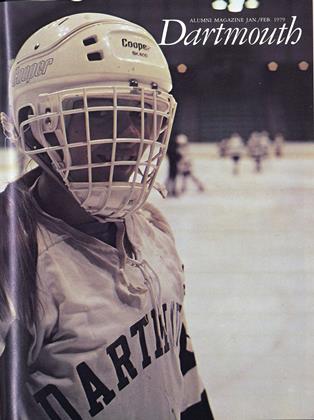A couple of days before Thanksgiving, an exhibit titled "A Tribute to George Maciunas (1931-1978)" opened in the Beaumont-May Gallery in Hopkins Center. George Maciunas was the founder of a movement called Fluxus. The exhibit was still there shortly before Christmas, and as a relief from her workaday duties, Ms. G., our most impressionable reporter, went to have a look. Here are her notes:
Fluxus is not a movement, not a school of art, but a loose association of like-minded spirits founded by Maciunas in the early sixties. Fluxus explores what lies beyond the object as a work of art, beyond formal art situations. It dissolves the boundaries between the artist and the viewer, between the performer and the audience. Fluxus is non-art amusement. Fluxus is fun.
Fluxus is a moveable feast, says Jan van der Marck, director of Dartmouth's museums and galleries and founder of the Dartmouth Maciunas Memorial Collection. Fluxus events qualify for what has been called the non-theater of composers, poets, and filmmakers. Fluxus asks the viewer to partake in games, puzzles, gags, and natural events.
Yoko Ono (remember Yoko Ono?), a Fluxus spirit, gave a Fluxus party in Japan, a "Fly Event." People were invited to come fly by any method of their invention. Many methods were tried or proposed. Ms. Ono did not attend.
Van der Marck gives a tour of the Fluxus exhibit at Dartmouth in a white coat and a Flux-tour hat. A gorilla mask is optional.
At the Fluxus exhibit of non-art at Dartmouth we are invited to:
• Put our hand into the Tactile Box, a wooden box with a small hole to insert your hand into at the top. It's a little scary at first because you don't know what to expect. I thought what I felt was money.
• Engage in our own concert of telepathic music. There is a score on a music stand in the middle of the room that reads:
Concentrate silently Send waves of greetings weatherluck manluck womanluck to all members of the eternal network the world around.
• See a rubber food kit.
• See a model of Claes Oldenburg's abandoned prototype of a soft ketchup bottle. Dan thought it was a ham bone.
• See the Universal Machine, which gives directions for writing a novel, finding a friend, and finding a lost article. It says that this can be done by shaking the box and contents, opening it, and the answer will be there. The box is in a glass case, so we are unable to find those answers.
• See a television on its side, with a' salmon-and-white case, which is operating but has only a vertical line on the screen. Actually, it is a horizontal line because the television is on its side. It all relates to Zen, according to a write-up on the wall.
• See a Sky Painting. This is a sheet painted blue with clouds on it hung from a clothesline with clothespins that also are blue. A woman from Norwich was gazing at it and said it reminded her of an oilcloth painting done by the Norwich Independents a few years ago. The Norwich Independents was founded so that its members could decline unfavorable invitations by saying they were going to a meeting of the Norwich Independents. The oilcloth painting they created was of a steeplechase, and the Independents would move various animals around the course during their meetings.
The woman from Norwich remarked that nothing is original.
 View Full Issue
View Full Issue
More From This Issue
-
 Feature
FeatureDr. Hot's Thermal Therapy
January | February 1979 By Bill Galvin -
 Feature
FeaturePresident on Trial
January | February 1979 By Marilyn Tobias -
 Feature
FeatureThe Old Sod: Summits Above and Graves Below
January | February 1979 By Ann Lloyd McLane -
 Feature
FeatureWomensports
January | February 1979 -
 Article
ArticleWriter Possessed
January | February 1979 By M.B.R. -
 Article
ArticleIt Flew
January | February 1979 By TIM TAYLOR '79








